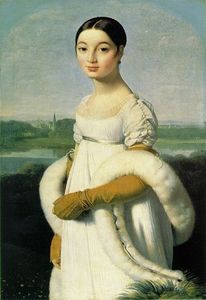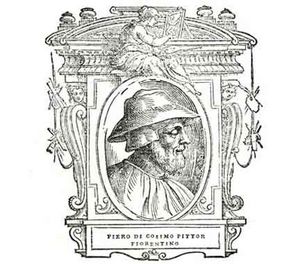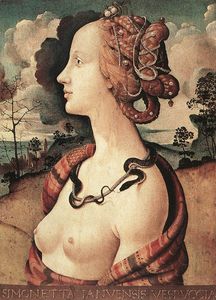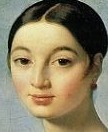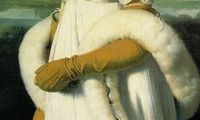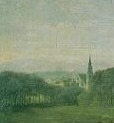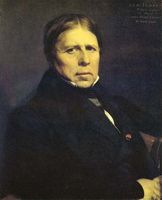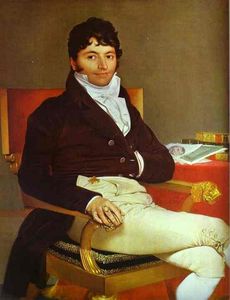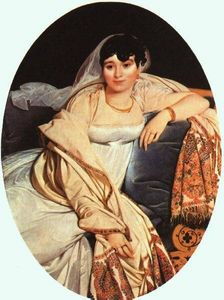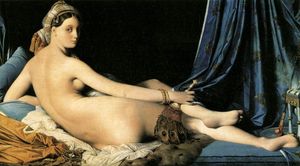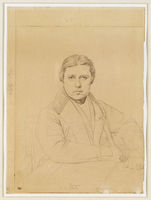Mademoiselle Caroline Rivière
- Date of Creation:
- 1806
- Height (cm):
- 100.00
- Length (cm):
- 70.00
- Medium:
- Oil
- Support:
- Canvas
- Subject:
- Figure
- Framed:
- Yes
- Art Movement:
- Neoclassicism
- Created by:
- Current Location:
- Paris, France
- Displayed at:
- Musée du Louvre
- Owner:
- Musée du Louvre
- Mademoiselle Caroline Rivière Page's Content
- Story / Theme
- Inspirations for the Work
- Analysis
- Critical Reception
- Related Paintings
- Locations Through Time - Notable Sales
- Artist
- Art Period
- Bibliography
Mademoiselle Caroline Rivière Story / Theme
Portrait Drawings:
Ingres' student, Robert Balze, described his teacher's working routine for portrait drawings. In the four hours he took for each work he used "an hour and a half in the morning, then two-and-a-half hours in the afternoon, he very rarely retouched it the next day. He often told me that he got the essence of the portrait while lunching with the model who, off guard, became more natural."
Although he was supposed to go to Rome, due to financial problems Ingres was forced to stay in Paris until 1806. During this period, much to his dismay, he made a living from drawing and painting portraits. Though the artist himself preferred history paintings, his portraits are among the most admired of his works.
Ingres painted Napoleon I on His Imperial Throne, a self-portrait, and Mademoiselle Caroline Riviére, all of which were painted on a large canvas.
Ingres painted Madamoiselle Caroline along with her father Philibert Riviére, the Councilor of the State, and her mother Madame Riviére. Caroline, just fifteen when this portrait was painted, died that same year. This work remains the only one Ingres did of an adolescent. All three portraits, along with that of Napoleon were exhibited at the 1806 Salon.
Mademoiselle Caroline Rivière Inspirations for the Work
Like all influential artists, Ingres was known to study the great masters before him. Though they indirectly influenced his work, Ingres developed his own style. Although there is no actual proof, Ingres' inspiration for Mademoiselle Caroline Riviére may have come from a lesser known Renaissance artist, Piero di Cosimo. Similarities can be drawn as Cosimo also displays the sexuality of a young woman but very obviously. Ingres merely hints at this.
After 1797 while in Paris, Ingres studied in the studio of Jacques-Louis David. Though he earnestly studied the principals of composition and human anatomy, Ingres developed his own style, creating anatomical distortions as evident in Caroline Riviére's portrait.
There are other works however that may have more specifically influenced this portrait.
Simonetta Vespucci:
Some art historians have connected the portrait of Madamoiselle Caroline Riviére to the similarly "gothic" Portrait of Simonetta Vespucci by Piero di Cosimo. This Italian Renaissance painter, portrays Simonetta circa 1480 as Cleopatra with a snake around her neck and shawl wrapped over her shoulders but revealing her breasts. Though Caroline remains unexposed, the bower around her waist mimics the sexual suggestions hinted at by the snake around Simonetta's neck.
Mademoiselle Caroline Rivière Analysis
The portrait of Mademoiselle Caroline Riviére is the only adolescent portrait Ingres completed. This representation, often characterized as "gothic", flaunts Ingres' unique technique of his anatomical distortions and outlining of figures. Ingres plays up his subjects' innocence while depicting in a hidden sexuality that he brings to all his female figures through tone, color and lighting.
Use of Space:
The figure of Mademoiselle Caroline Riviére takes up the foremost portion of the canvas. She stands boldly in front of a flat background and underneath an archway that frames the canvas. It seems a little cramped and sometimes this portrait, as well as some of Ingres's others, is described as "suffocating". Ingres leaves a little breathing room on the left side of the canvas as the figure stands closer to the right edge. The landscape takes up minimal space in the background.
Anatomical Distortions:
Ingres borrowed the sitter's pose from his role model, Raphael. Unlike the great Italian master however, Ingres painted with extreme anatomical inaccuracy. Caroline Riviére's neck is noticeably elongated and the bridge of her nose extends into her brow. Such "tweaking" outraged critics of his day.
Outline:
Ingres often outlined his figures giving them a certain feel of flatness that caused critics to label his work "gothic."
Use of Color:
The white of Caroline's dress and bower make the young figure pop off of the canvas as she stands in front of a dismal, dreary and distant bluish-green landscape. Her porcelain skin makes her dark eyes and ebony hair all the more youthful and they provide an excellent contrast. Ingres paints her full lips in a natural pinkish hue echoing the color of youth that resides on her cheeks.
The artist's choice of white dress signifies her purity and though the bower twirled around her is also the color of innocence, its curvature lends credence to a peaking sexual interest.
Lighting:
The figure of Caroline Reviére is outlined in a shadow, a common technique for Ingres. Light rests on her forehead and collar bone and the ribbon just below her bust catches a glimpse of light.
Tone elicited:
Though the 15-year-old is dressed and adorned in the color of innocence, and her expression reveals "simple thoughts" some critics take note of the sexuality Ingres suggests in the portrait of the adolescent. Her lips are supple and he elongates her bare neck. Her long gloves are matched by an even longer bower that circles her tiny frame, signifying sexuality.
The town behind and below her resides into a quiet shadow giving an overall calming effect.
Brushstroke:
Ingres was said to have hated a "noticeable" brushstroke. On this canvas, as well as most of his other works, he uses a tight brushstroke to create the photorealism of this portrait. The tightness of his brushwork enabled Ingres to create surfaces and textures that so closely resembled real life: the fluffy fur of the bower, the ridges in her dress, the satin of the ribbon below her bust, the sheer trim of her trace and the smooth suede of her gloves.
Mademoiselle Caroline Rivière Critical Reception
When Ingres first exhibited Mademoiselle Caroline Riviére at the Salon of 1806 he didn't exactly receive the attention he had hoped for. Caroline's portrait was definitely noticed, but more for what critics believe to be a digression to the art world instead of progress. They attacked his style, his return to gothic and primitive art and ridiculed the artist for his anatomical distortions.
Critics of later ages would finally come to recognize the undeniable talent of Ingres' fashion sense in this portrait as would later focus on its undeniable sexuality when compared to his later paintings of harem women.
Mademoiselle Caroline Rivière Related Paintings
Mademoiselle Caroline Rivière Locations Through Time - Notable Sales
Mademoiselle Caroline Rivière was bequeathed to the Louvre in 1870 by Caroline Rivière's sister-in-law.
Mademoiselle Caroline Rivière Artist
Ingres studied with Neoclassical master, Jacques-Louis David, who invoked the importance of the line in drawing. Ingres had a long lasting career and during his lifetime he experienced both disapproval and praise from critics, in equally strong capacities. Before earning the rank of "best living artist in France," he spent many years being the most loathed. He was heavily criticized for the anatomical distortions he added to the young figure in Mademoiselle Caroline Riviére.
Mademoiselle Caroline Rivière Art Period
Neoclassicism is the 18th century revival of classical beliefs. It differs from other revivals as Neoclassical artists approached the ancient subject with a newer, more scientific approach. They also combined an interest in both ancient worlds; Greece and Rome. The artifacts uncovered at Pompeii and Herculaneum contributed significantly to this rebirth of classicism.
Jean-Auguste-Dominique Ingres absorbed the newly discovered ancient art. He studied it intently and was often criticized for reviving the ancient style. He also portrayed the absolute truth of life through the "pure and simple" verities of antiquity. Neoclassicism replaced the frivolity and superficiality of the Rococo era.
Mademoiselle Caroline Rivière Bibliography
Find out more about this and Ingres's other works by referrig to the recommended reading list below.
• Boime, Albert. Art in an Age of Bonapartism, 1800-1815. Chicago: Chicago University Press, 1993
• Fisher, Jay M. The Essence Of Line: French Drawings From Ingres To Degas. Pennsylvania: Pennsylvania State University Press, July, 2005
• Grimme, Karin H. Jean Auguste Dominique Ingres: Taschen Basic Art. New York: TASCHEN, December, 2006
• Vigne, Georges. Ingres. London: Abbeville Press, Incorporated. October, 1995

